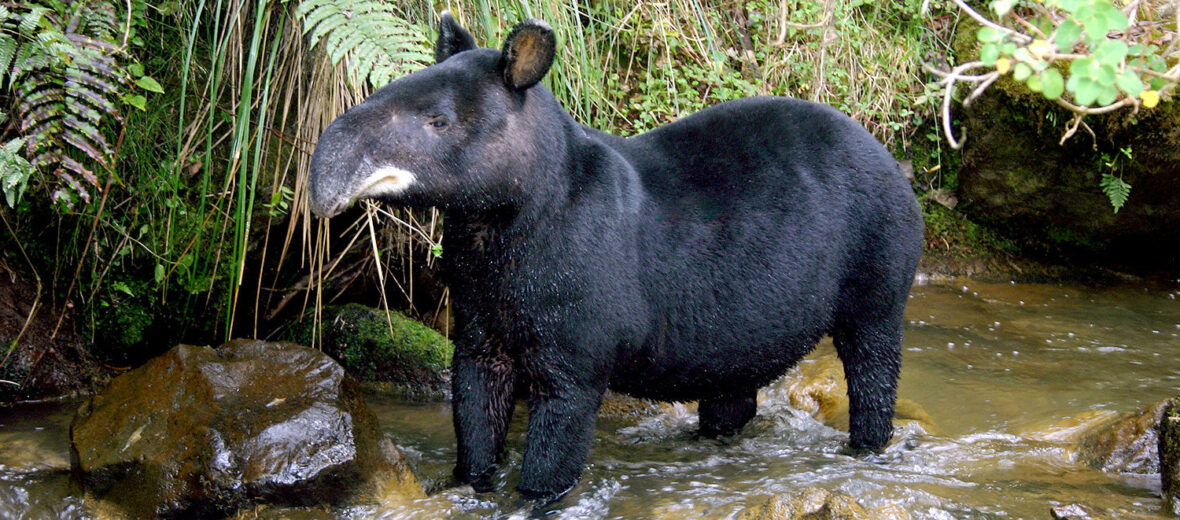
The mountain tapir, aka Andean tapir or woolly tapir, can be found in Colombia, Ecuador, and Peru. They prefer alpine meadows, mid & high-level montane cloud forests, and páramo grasslands, aka treeless moorlands. Due to deforestation at the hands of logging, farming, ranching, and mining; hunting; and trapping, these incredible creatures are have been reduced to just 2,500 wild individuals. That number was last assessed in 2016. Their numbers are decreasing as well. The IUCN lists these critters as Endangered.
First the Stats…
Scientific name: Tapirus pinchaque
Weight: Up to 550 lbs.
Length: Up to 5.9 feet
Height: Up to 3.3 feet, at the shoulders
Lifespan: Up to 30 years
Now on to the Facts!
1.) These tapirs have a prehensile tail that is used to grab onto leaves and other vegetation.
2.) Mountain tapirs are crepuscular (active at dusk and dawn).
3.) They are skilled swimmers and can stay submerged completely for several minutes.
4.) When threatened, they will either flee into the forest or escape to a body of water, using their snout as a snorkel to allow them to stay submerged for longer, until the threat is gone.
5.) Once thought to be solitary, it was later discovered that these beasts actually dwell in pairs and/or in small family herds.
But wait, there’s more on the mountain tapir!
6.) A group of tapirs is called a herd or candle.
7.) Communication consists of scent marking with urine and emitting shrill whistles.
Did you know…?
Their species name hails from La Pinchaque, a mythical creature said to roam in the same region as the mountain tapir.
8.) Being herbivores (eat plant matter), these critters graze daily on various leaves, grasses, seeds, and fruit.
9.) Monogamy (mating for life) often occurs.
10.) Females undergo up to a 13 month gestation (pregnancy) that yields a single calf.
But wait, there’s still more on the mountain tapir!
11.) Calves are independent in up to 1 year.
12.) Due to the pressures of ranching, these tapirs are continually at risk of bovine-related diseases like bovine viral diarrhea (BVD), foot and mouth disease (FMD), bovine spongiform encephalopathy (BSE), brucellosis, and anthrax, to name a few.
Did you know…?
Mountain tapirs are said to smell like a crate of lettuce.
13.) Seeing as their diet consists of various plants and fruit, they are important seed dispersers. They also routinely turn over fallen trees which aids in providing food for other smaller creatures.
14.) They may look cumbersome, but these tapirs can also traverse tough to navigate terrain like snow banks, glaciers, and mountainous habitats.
15.) These tapirs were initially discovered by the French naturalist Roulin, in the eastern Andes of Colombia.
But wait, there’s still a little more on the mountain tapir!
16.) With their finely tuned sense of smell, these critters can find lettuce leaves from numerous feet away.
17.) Tapirs are closely related to rhinoceroses and horses.
18.) Mountain lions, spectacled bears, jaguars, and crocodiles all prey on these tapirs.
Now a Short Mountain Tapir Video!
Be sure to share & comment below! Also, check out the Critter Science YouTube channel. Videos added regularly!
Want to suggest a critter for me to write about? Let me know here.
Some source material acquired from: Wikipedia & IUCN
Photo credit: Tapir Specialist Group



